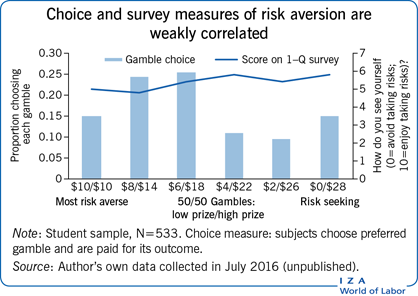Elevator pitch
Risk aversion is an important factor in many settings, including individual decisions about investment or occupational choice, and government choices about policies affecting environmental, industrial, or health risks. Risk preferences are measured using surveys or incentivized games with real consequences. Reviewing the different approaches to measuring individual risk aversion shows that the best approach will depend on the question being asked and the study's target population. In particular, economists’ gold standard of incentivized games may not be superior to surveys in all settings.

Key findings
Pros
Incentivized tasks are designed so that subjects have an incentive to truthfully report their preferences, while it is costless for subjects to misrepresent their preferences in surveys.
Incentivized games can be structured to provide a precise measure of preferences that can be used to discriminate between different theories of decision making and to statistically estimate a subject's underlying value function (utility function).
Survey measures lack a clear connection to theory, and therefore cannot be structured in the same way as incentivized games.
Cons
Subjects may find incentivized games to be difficult or confusing, while surveys tend to be simpler to understand; this is particularly true for less-educated subjects.
Incentivized games are costly to administer in terms of time (instructions can be complex) and money (incentives must be provided).
It is difficult to adapt incentivized games to represent different decision contexts, while surveys are easier to adapt.